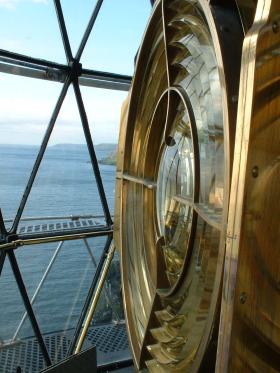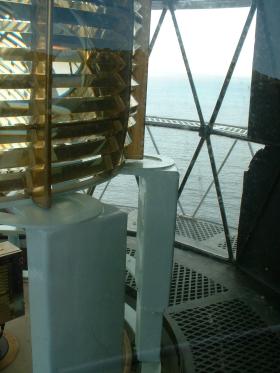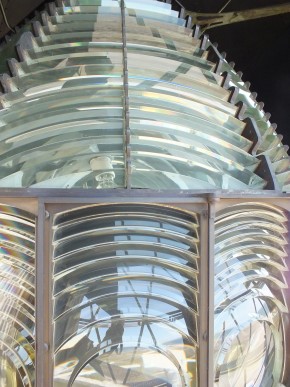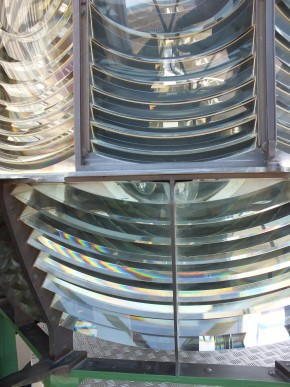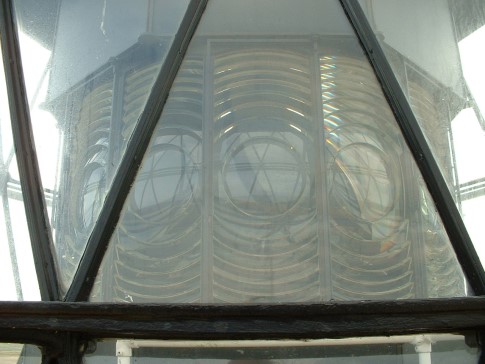|
1st Order Lens
Part of Main Lens----------------- Weight Boxes used to balance lens

Point of Ayre
Character change on automation
The red shades were removed from the bullseye lens, eight lens were blanked off to give four clear-four blank etc and the rotation set at a revolution every 40 seconds giving the character FL(4)20 sec.
Ardnamurchen This had a beehive lens the character being derived by means of a cylinder with two slots rotating around the lamp
Girdleness No lens there but a pair of parabolic mirrors rotating around the lamp.
How did they make the prisms? An extract from PHAROS The Lighthouse Yesterday,Today and Tomorrow by Kenneth Sutton-Jones In the poor light one made out on both sides of the central passage a score or more great rotating tables supported on heavy iron frames. Power for these tables,and the undulating cranks and cams over each was transmitted by belting and line shafts which provided an all pervading drone.Amid this unreality the men themselves appeared pallid and worn out creatures of the dungeon. The founding of the glass prisms and rings took place in a nearby building within the 'glassus' by men simultaneously 'unrolling' blobs of glass from the ends of tubes into an annular iron mould.A period of annealing followed in a special oven.The really large prismatic rings had to be cast in segments,a formidable task when one considers the hundreds of elements within a large lighthouse optic. Then,after annealing,the rough looking elements were ground flat on one face and stuck with pitch to form a ring on a turntable. Each prismatic ring had three faces,two flat and one curved.The curved face and one of the flat sides were ground to correct shape using grinding powders of diminishing coarness and rubbing pads which the machinery caused to abrade across the glass surfaces. Conformity to shape was gauged by templates and feeler gauges and,when complete,the whole glass ring was inverted and a plaster mould made to accomodate the shape so that the remaining flat surface could be ground.The processes were repeated using polishing media until a jewel-like finish was obtained.Each prism was tested on a special machine where very narrow parallel rays of light were made to traverse across the surface of the glass and conformity with the correct focal point was recorded. What appeared to be a rough grinding process achieved of surprising accuracy whereby a prismatic ring 1.5 metres in diameter displayed a focal conformity to within a circle only 2 millimetres in diameter.
How did they line up the prisms when they built the lens? Extract from Lighthouses by Rosemary Garland
At the lighthouse workshops where the optics are made for export all over the world,each prism bar of the glass cage has to be carefully tested to make sure that it is at its correct angle.This is a difficult task as the testing has to be done in a small space. |
If you have heard reference to something like it's "a fourth order lens" it refers to the size.
The Order depends upon the focal length of the lens.
| Type | Radius in millimeters | Radius in inches |
| Hyperradial | 1330 | 52-3/8 |
| Mesoradial | 1120 | 39-7/8 |
| 1st.Order | 920 | 36-1/4 |
| 2nd..Order | 700 | 27-1/2 |
| 3rd..Order | 500 | 19-3/4 |
| 3rd..Order small | 375 | 14-3/4 |
| 4th..Order | 250 | 9-3/4 |
| 5th..Order | 187.5 | 7-3/8 |
| 6th.Order | 150 | 5-7/8 |
|
Therefore a 1st.order lens has a focal length of 920 mm or 36-1/4 inches and is 1840 millimeters or 6ft and half an inch in diameter,which gives plenty of room to work inside but is an awful lot of lens to clean.
MESORADIAL LENSES Still in use at
Abrolhos Island Lighthouse in Brazil made by Barbier & Bénard 1898
|
